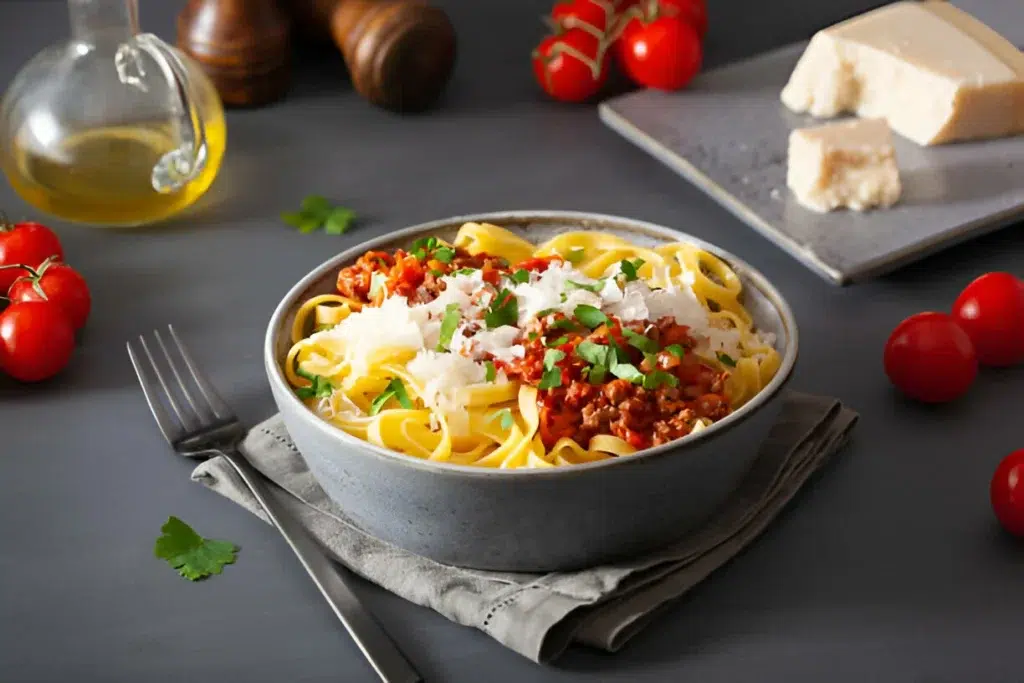
The Wonderful World of Pasta
Pasta, a versatile and delicious staple food enjoyed worldwide, comes in a staggering array of shapes and sizes. From the long, thin strands of spaghetti to the bite-sized pockets of ravioli, each type offers a unique culinary experience. But beyond the visual and textural variety, understanding different pasta shapes goes hand-in-hand with creating truly exceptional dishes. Take, for example, the debate between mafaldine vs reginette, both beautiful ruffled pastas. While similar in appearance, their subtle differences can impact how they pair with sauces and enhance your dish.
Let’s fix the pasta passage!
A Tale of Two Ribbons: Mafaldine and Reginette
Mafaldine and Reginette, both with beautiful ruffled edges, boast a fascinating history linked to Italian royalty and culinary innovation.
Mafaldine’s Royal Roots:
Hailing from Naples, Mafaldine wasn’t always called that. Originally known as “fettuccelle ricce” (meaning “curly ribbons”), it got a name change in the early 1900s. Neapolitan pasta makers cleverly renamed it “mafalda” or “mafaldine” to celebrate the birth of Princess Mafalda of Savoy, daughter of King Victor Emmanuel III. Some say the wavy edges were inspired by the intricate lace on dresses of nobility, a fitting tribute.
Reginette’s Regal Connection:
“Reginette,” which translates to “little queens,” is another name for Mafaldine. While the exact origin of this term is unclear, it likely emerged alongside “mafalda” to emphasize the pasta’s royal connection. However, there’s a chance Reginette might have existed earlier as a similar ruffled pasta enjoyed in specific Italian regions. Regardless, both names solidified the pasta’s association with royalty, adding elegance to this delightful creation.
Princess Mafalda’s life story took a tragic turn, but that doesn’t diminish the enduring legacy of the pasta named after her. It remains a testament to Italian culinary ingenuity and its connection to historical figures.
Mafaldine’s Royal Roots:
Originally known as “fettuccelle ricce,” Neapolitan pasta makers cleverly renamed it “mafalda” or “mafaldine” in the early 1900s to celebrate the birth of Princess Mafalda of Savoy. Some say the wavy edges were inspired by the intricate lace adorning the dresses of nobility.
The Shape of Royalty: Unveiling mafaldine vs reginette
Mafaldine: The Queen of Ribbons
Mafaldine, a vision of elegance on your plate, boasts a long, flat shape similar to fettuccine. But unlike its fettuccine cousin, Mafaldine features delightful ruffled edges that resemble the frills of royalty. These wavy borders not only add visual intrigue but also play a crucial role in capturing sauces. The ridges provide a delightful textural contrast – smooth on the flat surface and a nice bite from the ruffled edges. This textural interplay enhances the pasta-sauce experience in every mouthful.
Reginette: The Little Queen
Reginette, another name for Mafaldine, perfectly translates to “little queens.” This moniker reflects its close resemblance to Mafaldine and its association with Italian nobility. Reginette embodies the same physical characteristics as Mafaldine – long, flat strands with beautifully ruffled edges. These frilled borders not only elevate the presentation but also contribute to the textural enjoyment of the pasta. The smooth center allows the sauce to evenly coat, while the ruffled edges trap delicious pockets of sauce, adding another dimension of flavor with every bite. So, whether you call it Mafaldine or Reginette, this regal pasta is sure to add a touch of elegance and delightful texture to your culinary creations.
A Royal Affair in the Kitchen: Cooking with mafaldine vs reginette
Mafaldine Takes Center Stage
Mafaldine’s unique shape makes it a versatile player in the culinary world. Its ruffled edges excel at capturing rich, chunky sauces, ensuring every bite bursts with flavor. Neapolitans traditionally pair Mafaldine with lighter sauces, like ” ricotta in bianco” featuring sheep’s milk ricotta, lardo (cured pork fatback), and pecorino cheese. But its versatility shines with seafood or meat sauces as well. Imagine Mafaldine embracing a vibrant pesto or a creamy ragù, each morsel a delightful combination of pasta, sauce, and texture.
Reginette Reigns Supreme
Just like Mafaldine, Reginette thrives in dishes featuring chunky or creamy sauces. Its ruffled edges become little flavor pockets, capturing every bit of deliciousness. Think of Reginette bathed in a luscious tomato sauce with plump vegetables or a decadent carbonara clinging to its ridges. For a lighter touch, Reginette pairs beautifully with pesto or a simple garlic and olive oil sauce. The ruffled edges enhance the experience, adding a delightful textural dimension to each bite. So, whether you call it Mafaldine or Reginette, this regal pasta elevates any dish, transforming a simple meal into a culinary masterpiece.
A Touch of Royalty on Your Plate: The Cultural Significance of mafaldine vs reginette
Mafaldine: More Than Just Pasta
Mafaldine’s story weaves a fascinating tapestry beyond its delightful taste and texture. In Naples, its birthplace, it’s not just a pasta shape; it’s a tangible link to history. Neapolitans proudly renamed the pasta “mafalda” or “mafaldine” in the early 1900s to honor Princess Mafalda of Savoy. This act reflects the city’s connection to royalty. Interestingly, Puglia, another Italian region, celebrates St. Joseph’s Day on March 19th with a unique twist. Here, Mafaldine transforms into “La barba di San Giuseppe” (St. Joseph’s beard), symbolizing the saint’s facial hair. This creative dish highlights the regional variations and cultural significance surrounding Mafaldine.
Reginette: A Symbol of Elegance
Reginette, the other name for Mafaldine, carries its own cultural weight. The term itself translates to “little queens,” further solidifying the pasta’s association with royalty. While the exact origin of the name “reginette” might be debated, it undoubtedly adds a touch of elegance to this delightful dish. Regardless of the name used, Mafaldine (or Reginette) embodies Italian culinary tradition with a touch of historical whimsy. It serves as a reminder that food can connect us to the past, enriching our present-day culinary experiences. From celebratory dishes to regional variations, Mafaldine stands as a testament to the cultural richness of Italian cuisine.
Frequently Asked Questions: Unveiling the Mysteries of mafaldine vs reginette
Q: Are Mafaldine and Reginette the same pasta?
A: Absolutely! Mafaldine is the more common name, while Reginette translates to “little queens” in Italian and acts as another term for the same delightful pasta shape.
Q: What sets Mafaldine apart from Pappardelle?
A: Both are long, flat ribbon pastas, but Mafaldine features beautiful ruffled edges, adding textural intrigue. In contrast, Pappardelle boasts straight, smooth sides.
Q: What kind of sauces are ideal for Mafaldine/Reginette?
A: The ruffled edges of Mafaldine and Reginette truly shine when paired with chunky or creamy sauces. These ridges provide little pockets that capture every bit of deliciousness. Traditionally, Neapolitans enjoy Mafaldine with lighter sauces, but its versatility allows it to pair beautifully with a wide range of options. Imagine Mafaldine embracing a vibrant pesto or a creamy ragù – each morsel a delightful combination of pasta, sauce, and texture.
Q: Where did Mafaldine originate?
A: Hailing from Naples, Italy, Mafaldine originally went by a different name: “fettuccelle ricce” (meaning “curly ribbons”). However, it received its current name in the early 1900s as a tribute to Princess Mafalda of Savoy.
Q: Is there a special dish featuring Mafaldine?
A: In Puglia, Italy, Mafaldine takes center stage on St. Joseph’s Day (March 19th). Here, it transforms into “La barba di San Giuseppe” (St. Joseph’s beard), a creative dish symbolizing the saint’s facial hair. This unique dish highlights the regional variations surrounding Mafaldine, showcasing its adaptability and cultural significance.
mafaldine vs reginette : A Delicious Conclusion
Our exploration of Mafaldine and Reginette reveals a fascinating world where a single pasta shape boasts two delightful names. Both embody the essence of long, flat ribbons adorned with beautiful ruffled edges, offering a unique textural experience. While Mafaldine might be the more common name, Reginette adds a touch of elegance, translating to “little queens” and reinforcing the pasta’s regal connection.
Understanding different pasta types goes beyond mere culinary knowledge. It unlocks a deeper appreciation for the rich tapestry of Italian cuisine. Each shape, like Mafaldine and Reginette, tells a story – of history, regional traditions, and culinary innovation. By understanding their unique characteristics, we can create truly exceptional pasta dishes, where form and function come together in a symphony of flavor and texture. So, the next time you reach for pasta, remember the story behind the shape. Embrace the delightful world of Mafaldine, or Reginette, and embark on a delicious culinary adventure!
References
- The International Pasta Organization: https://internationalpasta.org/
- The Oldways Preservation Trust (a non-profit focused on traditional Mediterranean dietary patterns): https://oldwayspt.org/
- Academia Barilla (a culinary institute founded by the Barilla pasta brand): https://www.academiabarilla.it/en/
Related Articles
For readers interested in the differences between mafaldine and reginette pastas, several articles on RecipesMaster.net can provide additional insights and related culinary knowledge. The article “Mafaldine Pasta” explores the unique characteristics and best uses of mafaldine pasta, which could help readers understand its specific qualities. A follow-up article, “Mafaldine Pasta 2”, may offer further detailed recipes or variations in preparing this pasta type. Additionally, for those looking to broaden their understanding of different pasta forms, the article “What is Kani made from?”, though focused on a different topic, touches upon ingredients and culinary uses which might be of interest to pasta enthusiasts looking to compare ingredient usage across different dishes.
